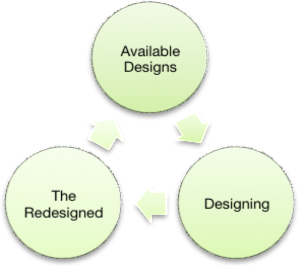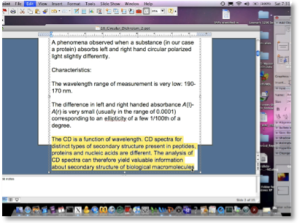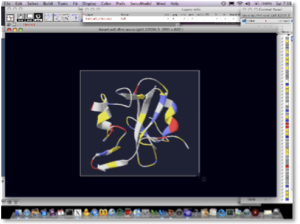“writing IS ‘words on paper,’ composed on the page with a pen or pencil by students who write words on paper, yes—but who also compose words and images and create audio files on Web logs (blogs), in word processors, with video editors and Web editors and in e-mail and on presentation software and in instant messaging and on listservs nd on bulletin boards—and no doubt in whatever genre will emerge in the next ten minutes” (Yancey, 2004, p. 298)
This research began while I worked as an educational technology instructor. I found myself caught in a conversational rainstorm about how we’re being transformed in these contemporary times. I was told that everything is being transformed: students, teachers, schools, and the whole of education. This affected me because I wanted to help yet I constantly had to guess what will be that next transformation. What really caught my attention was that I was also being told to get used to it because the way we create meaning is transforming: the New London Group (NLG), an international conglomeration of teachers and researchers, argued that contemporary meaning processes are cyclical transitions between available meaning resources–namely, designs, conventions, practices, and genres–being redesigned into new designs conventions, practices, genres. The old becomes the new becomes the old becomes the new. Furthermore, teachers were joining along and saying that writing also changed into something more inclusive than what I’ve previously known: Writing was all the modes of composition.
AN EXAMPLE OF A MULTIMODAL ENSEMBLE (transcript)
During my observations, I saw BB create texts containing content from a web tutorial created by another professor, sample work of one of her own graduate students, and take screen-captures of a course-related software. The content was revised, juxtaposed next to new content, drawn over with arrows to make new graphs, incorporated under headings and arranged in order to establish new associations. Furthermore, the content was combined with BB’s own voice-over narration and compiled into a series of multimodal ensembles. Throughout her multimodal composition process, BB cycled through a process of redesigning the very situation of the text into new educational contexts. She redesigned available meaning-making resources and produced redesigned teaching materials.
At the time of this observation, BB was creating a digital text on a specific scientific phenomenon that I was not familiar with called circular dichroism. In this instance, BB located content on the web containing much relevant information that she wanted to refer to on this topic. Namely, she sought out meaning-material and repurposed it for her text. In other words, she searched by navigating through content and locating it and repurposed it by embedding it in her digital text. The salient composing decisions of searching and repurposing (to be discussed in the Results section along with the salient composing decisions identified in this study) were observed at this point and were interspersed by planning decisions whereby she set tasks and goals that she wished to accomplish. These early decisions were directly related to BB’s recognition of available meaning-making resources with which to design her text.
As seen in Figure 8, BB selected a portion of words that she wanted to emphasize in her text. I know that this is her intent because while selecting that specific set of words, I observe her talking her planning decisions out loud: “this part needs to go … this part needs to go on a different slide. It’s a specific two proteins and other biological molecules, so I will put it someplace else.” As just mentioned, BB had already repurposed content from an online source and situated it within her own text, yet, once again, she treated the content within her own text as meaning-material that can be repurposed. So, I had observed the interaction between selecting and planning as pre-emptive decisions for repurposing. The interaction among the salient composing decisions can be seen in how BB planned her writing objectives by setting goals and simultaneously selecting content that she wanted to emphasize as part of her writing objectives. These decisions, in turn, led her to repurpose the selected content and form a new multimodal ensemble. Namely, the repurposed content is intended for an ensemble containing both the selected set of words and an image: “I know where I can put it. I’ll put it – it needs a picture. Let’s put a new slide.” Within the span of less than a minute, BB exhibited planning decisions by setting goals and organizing content, selecting by highlighting with her cursor content out of an array of modifiable content, and repurposing by copying and pasting content among PowerPoint slides. By observing both cognitive and on-the-screen behavior, I was able to see such complex interaction among her salient composing activities.
Furthermore, this moment illustrated the dynamics of digital content and how writers of digital texts at times treated content within their own texts as Available Design, namely meaning-material that can be remade and brought into new educational contexts. So, in this instance, designing activities meant for BB to shift back and forth between activities that transform content and recognizing the potential for content to be transformed, or, in reference back to the New London Group’s cyclic meaning-making process, BB shifted between recognizing Available Designs and Designing.
BB continued the process of producing a new multimodal ensemble by translating the repurposed content. Such translating activities included considering the technical aspect of her content. So, she omitted, added, and modified words amidst reviewing the content until she felt satisfied. She spoke her translating activities out loud:
“Random coil, huh? Now, let’s try random coil and beta sheets, random coil, etcetera. //CD is a bunch of wavelengths. CD spectra for distinct types of secondary structure present in peptides blah, blah. We don’t need distinct. We need different. //CD spectra present in peptides, proteins – and it says different here, too. Well, we don’t need that. Okay, let’s get rid of different completely, or CD spectra – I don’t like their wording. CD spectra for secondary structure present – structures present in peptides, proteins and nucleic acids – CD spectra – CD spectra profiles – the CD spectra for secondary – structures present in peptides differ – I don’t like their wording. //Try that. The peptides, protein, nucleic acids differ.”
Several minutes have gone by (long pauses are identified by double slash marks) and BB translated the meaning-material by deleting words (i.e. “let’s get rid of ‘different’ completely”), modifying them (i.e. “structures” instead of “structure”), and adding new words (as observed by her screen activities). She also reviewed her content by repeatedly reading it out loud. Once again, I observed the interaction among the salient composing decisions, though this time between translating and reviewing.
At this junction, BB returned to a goal she set for herself earlier, that of adding an image to her ensemble. She wondered where she would find such an image and searched for a possible image by navigating through a series of file menus. The image that she wanted to use was actually not a picture when she opened up the file. It was a visual produced by one of her graduate students using another software that visualizes chemical structures of molecules. The software allows the user to modify the visual but remains solely within the software (as seen in Figure 9).
BB spent several minutes modifying the visualized chemical structure of a protein by changing its orientation, size, and color. When she was satisfied she used another software to create an image version of the visual and then proceeded to embed this image within a PowerPoint slide. The software that she used to create the image (also known as screen-capture technology) again illustrated the writer’s capacity of recognizing how multimodal composition shifts between Available Designs and Designing: BB selected what part of the screen she wanted to create into an image and then she repurposed that image by embedding into another software. As with the repurposed set of words, BB used the content as another meaning-material and then translated it. Namely, she determined to repurpose a visual representation of a molecule produced by her student and then she reworked the content by translating its color and shape. She completed repurposing the modified visual by selecting what part of the screen she wanted to make into an image and then embedded the image file into the PowerPoint slide with the set of words she originally selected, repurposed, and translated (see Figure 10). This observation further clarifies how writers of digital texts do not just employ the six salient composing decisions identified in this study as isolated activities but rather emphasized that these salient decisions are part of the cyclic meaning-making process of remaking meaning resources. In other words, the six salient composing activities identified in this study are key to understanding how contemporary writers go about redesigning available meaning-making resources in order to create new educational contexts in digital formats.
At this point of BB’s process of assembling multimodal ensembles, she had brought together words and an image. She continued on by adding more visual and alphabetic content that further modified the repurposed image. She spoke her intent and new activities out loud:
“And then just to point out to the students the different structural elements, I’ll label them. I’ll do a few of them. I can do it maybe right here … Okay, now we need some arrows to point to that. //This is gonna be a pain, ‘cause the arrows are gonna be black inside of black. Gonna have to turn them to a different color. I’ll deal with that in a minute. … I wonder why this always comes up black? //Red. Where’s red? Find it. This is good. //Oh, that – actually, that worked pretty well, and then we need to make these – there, that’s not bad. Okay. And you have the beta sheets and the alpha helices and the idea that they will have different types of spectra, CD spectra. That gets the idea across.
As seen in Figure 10 again, BB added arrows with labels to identify varying aspects of the visual representation of the protein. Though I did not understand the science behind the content, I was interested in how BB reviewed her text based on its audience. Based on how the multimodal ensemble conveyed teachable content for her students, BB’s composing decisions once again treated repurposed content as Available Designs and then she planned a new goal to redesign the meaning-material. Beside reviewing and planning, the composing process included BB translating the content by resizing the image, modifying the color of the arrows, and adding new words. Though I did not get to observe the final stage of assembling this ensemble whereby BB incorporated her own voice-over narration, this observation illustrated how the six salient composing decisions were guided by the participant’s efforts to redesign meaning-material into new educational contexts.
Multimodal Ensemble by Bluetortugas3, unless otherwise expressly stated, is licensed under a Creative Commons Attribution 3.0 Unported License.



